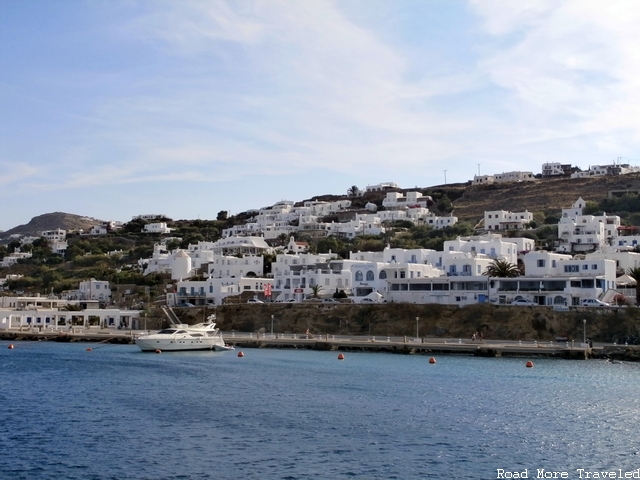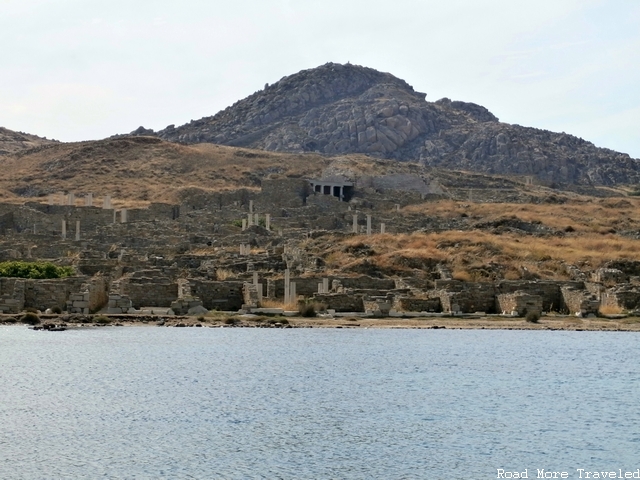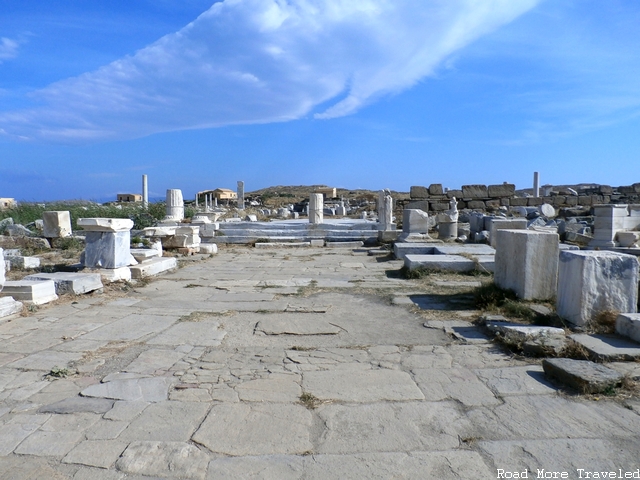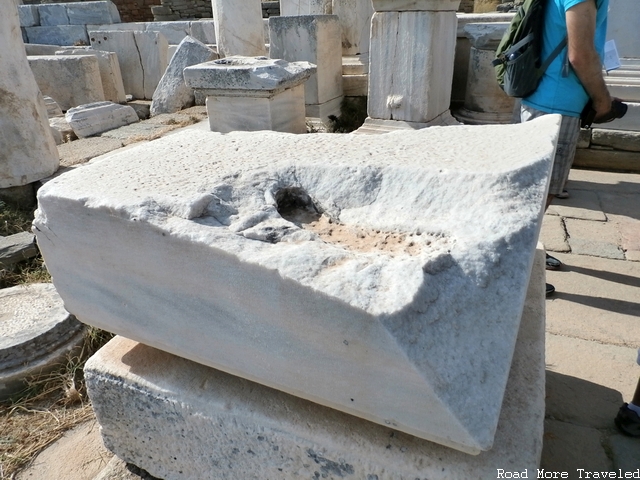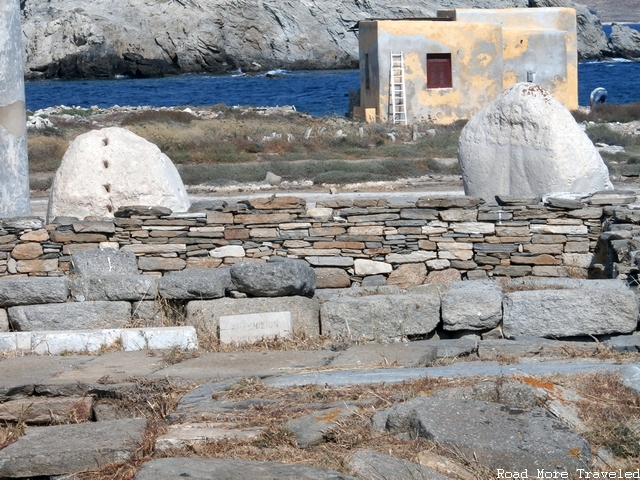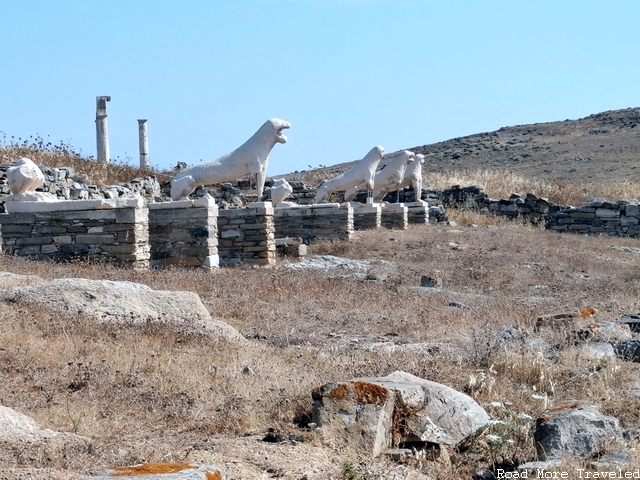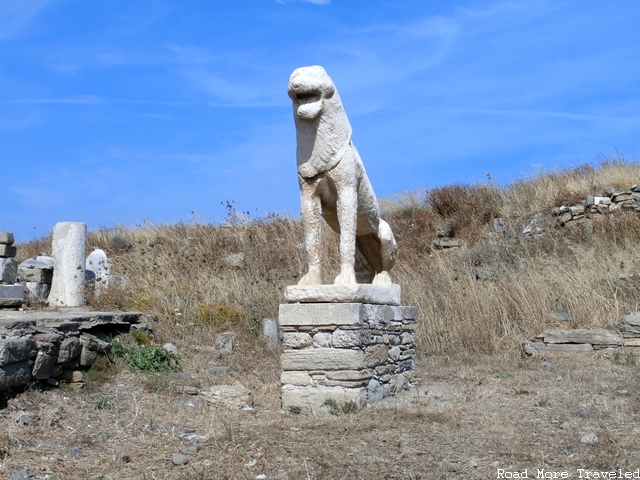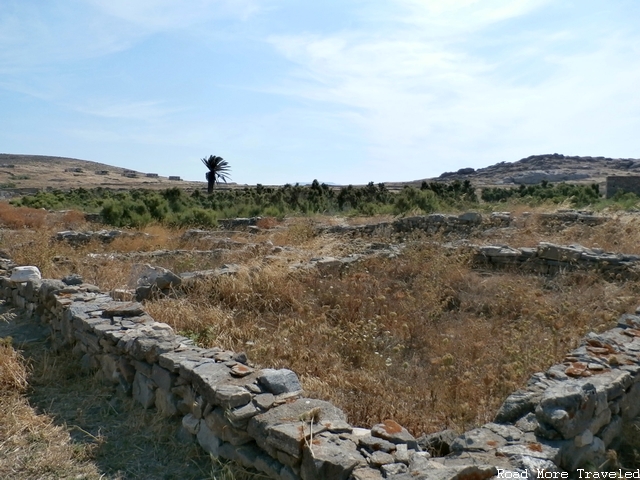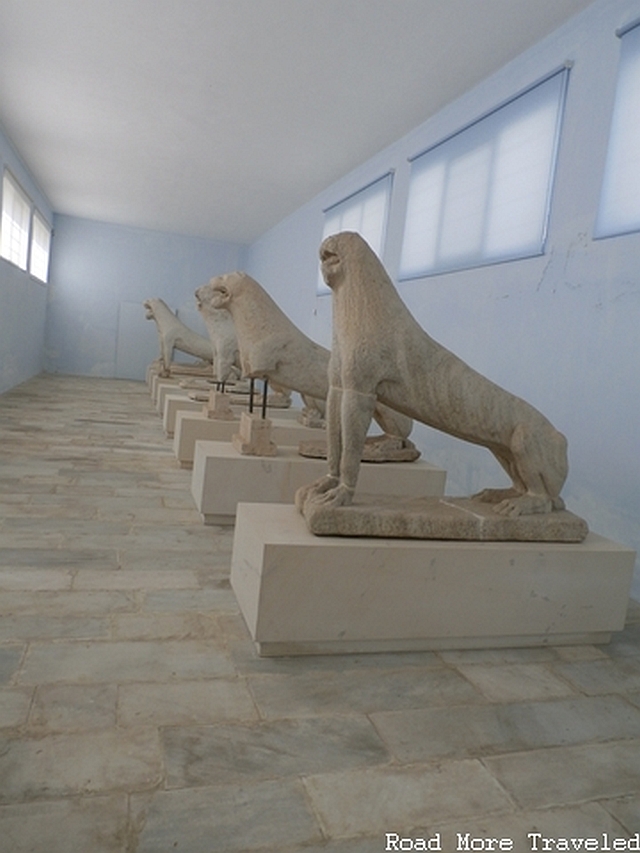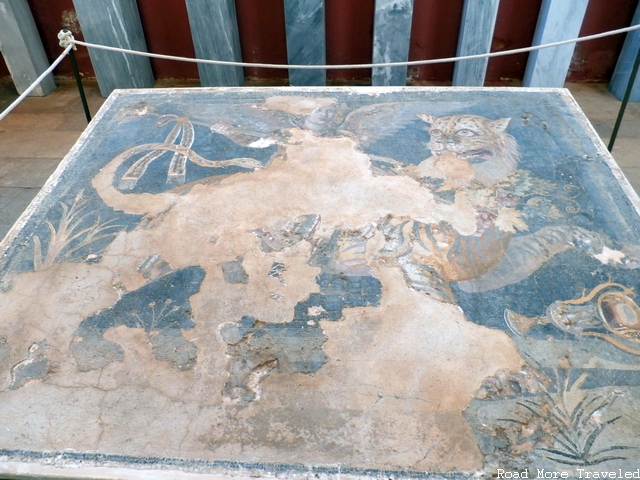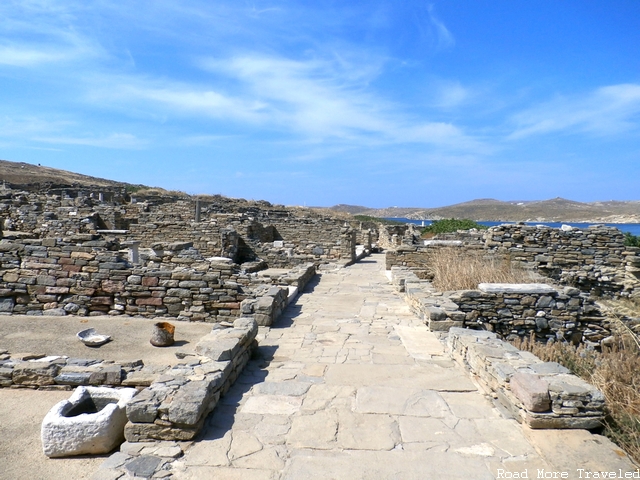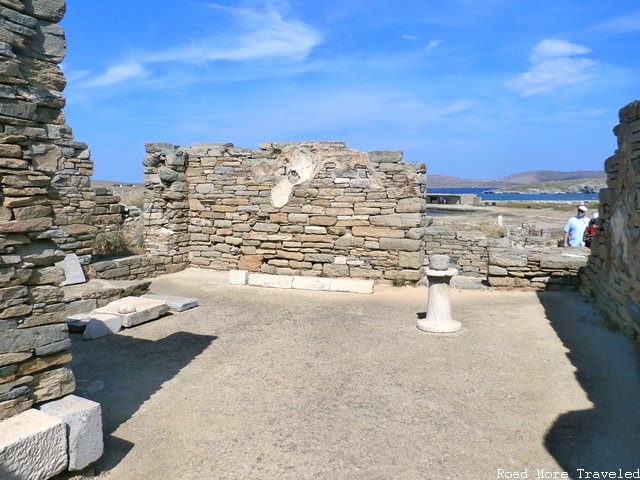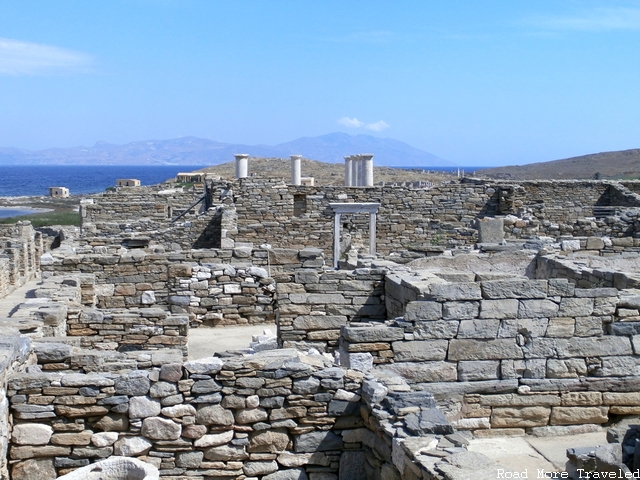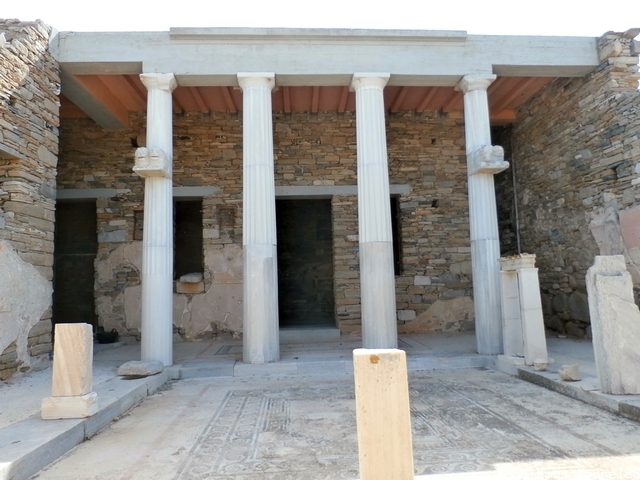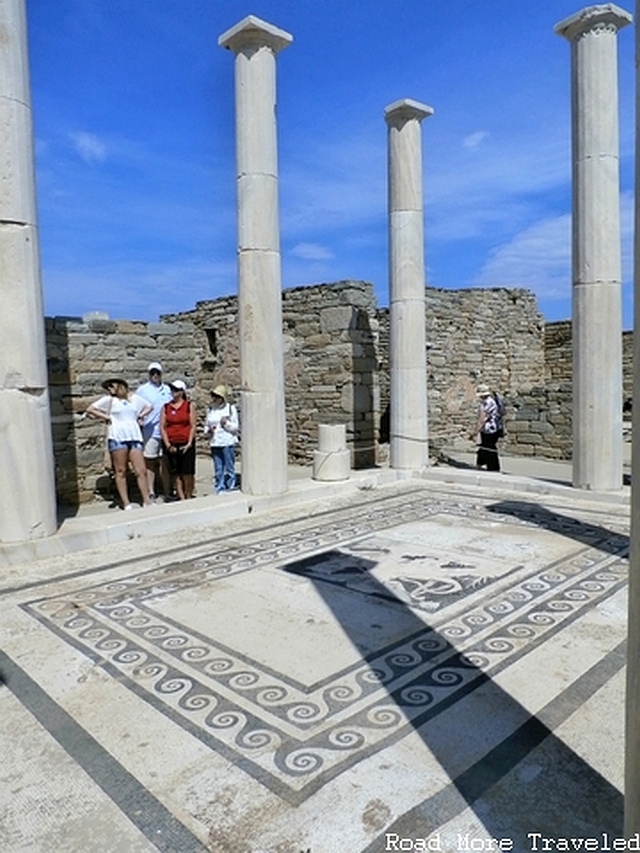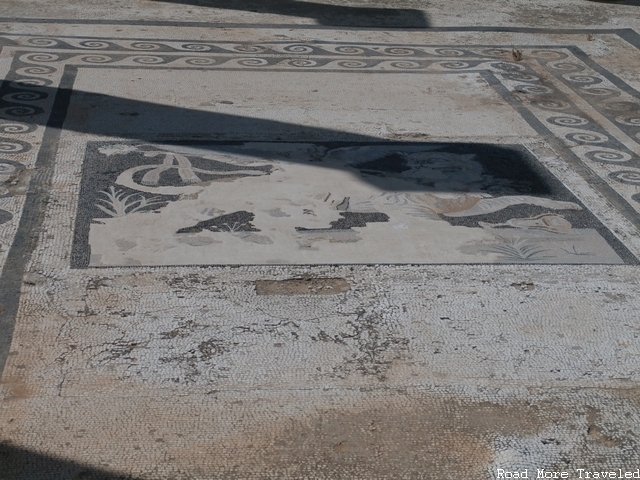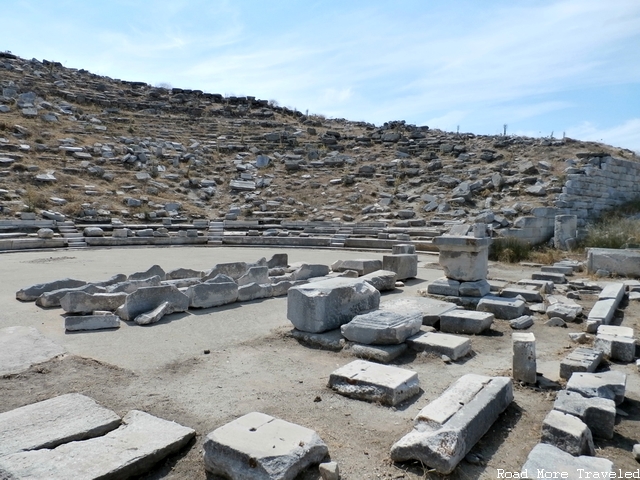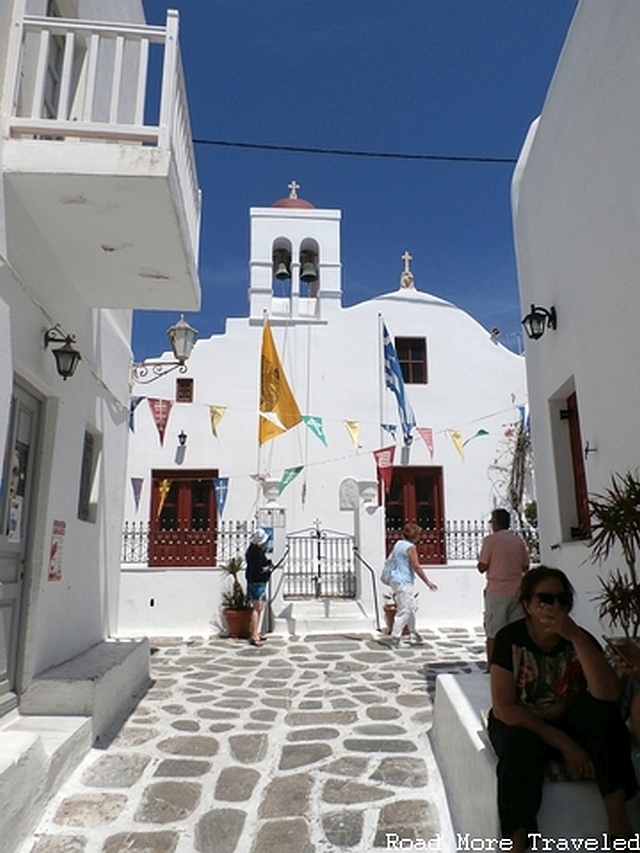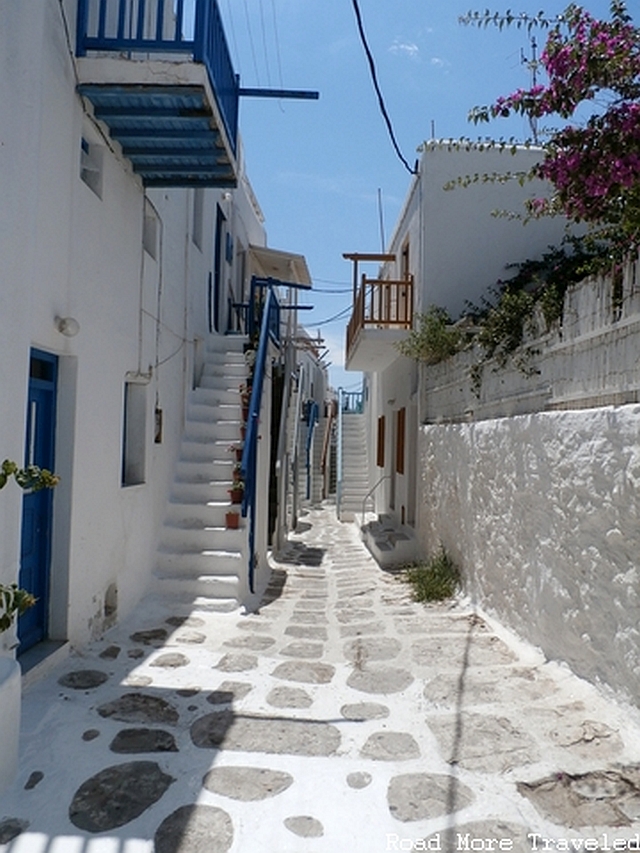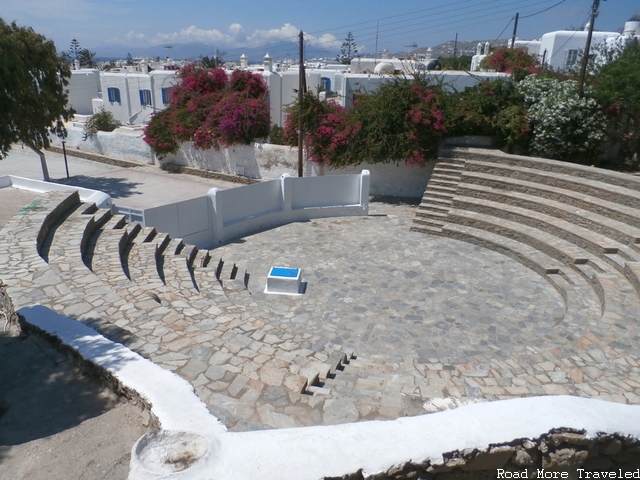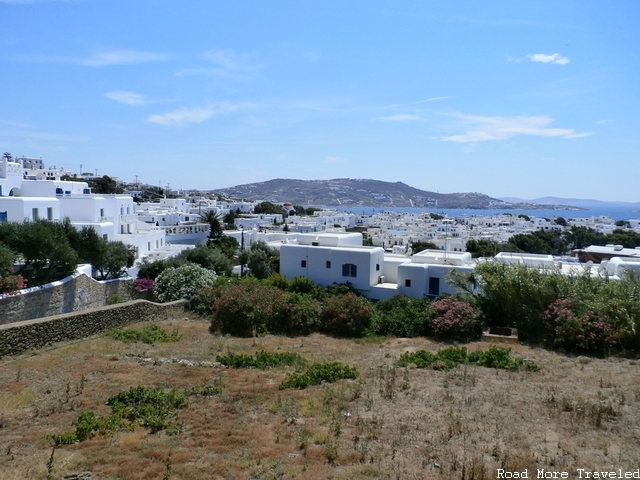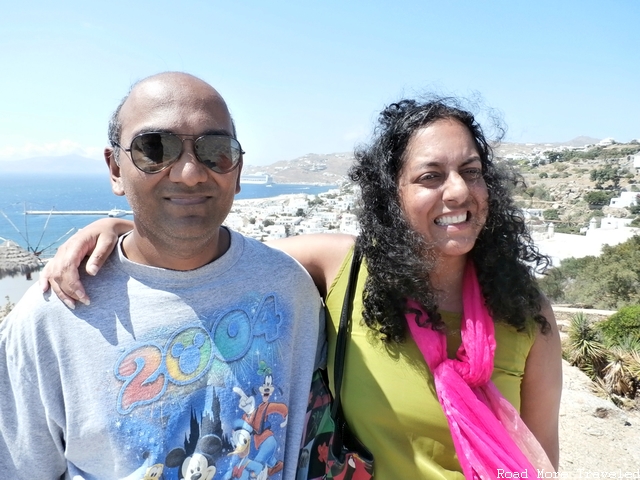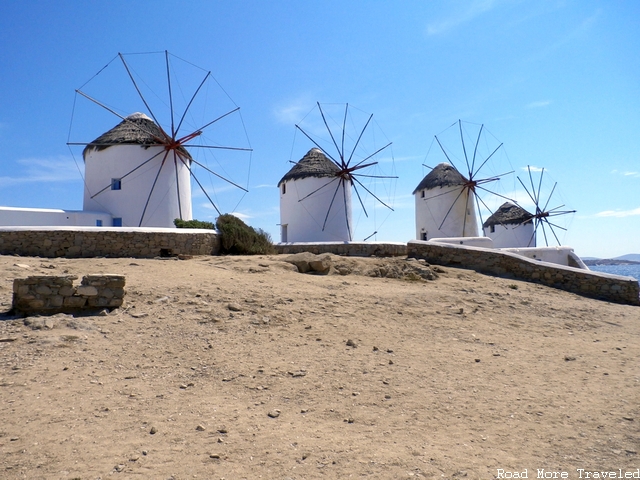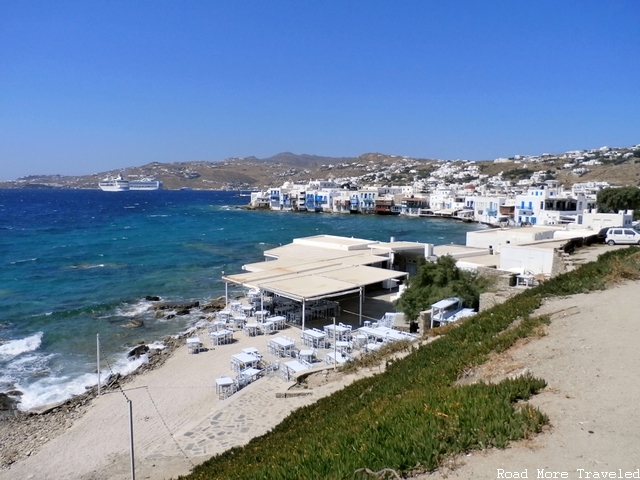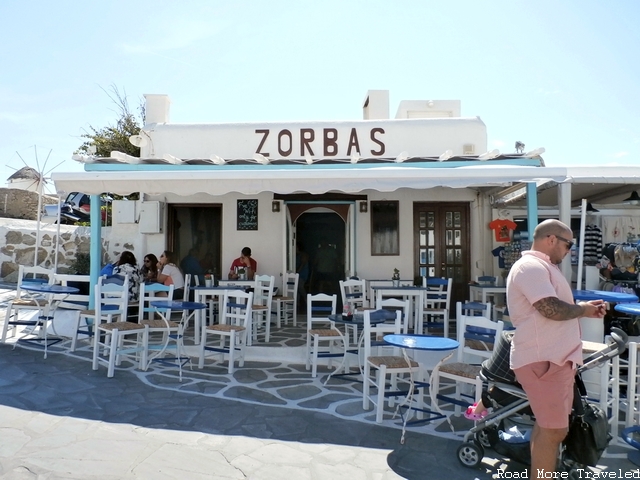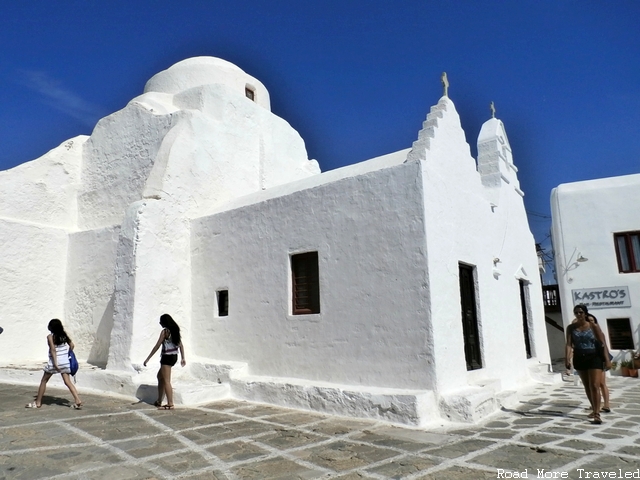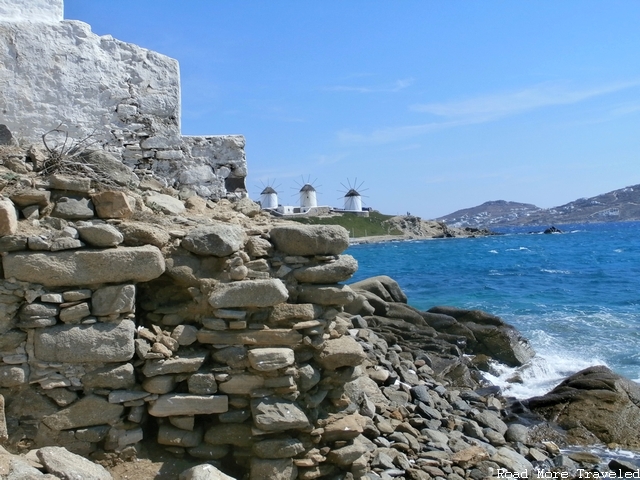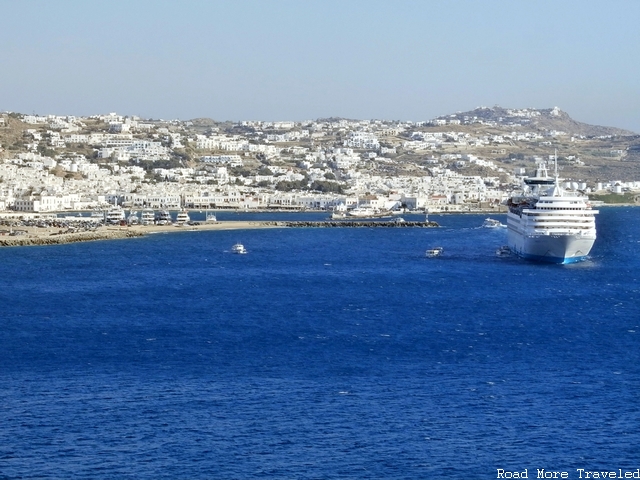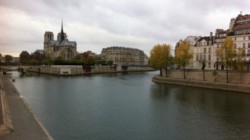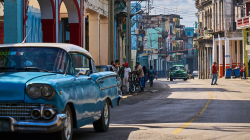Today, it’s time for a virtual tour of our first port-of-call on our Mediterranean cruise from Istanbul to Rome, the Greek isle of Mykonos. Though not as well known or frequently visited as the island of Santorini, Mykonos does have plenty of historical significance and natural beauty in its own right. You get the same azure-blue waters, fantastic beaches and picture-perfect, whitewashed towns of other islands in the Cyclades. For those who fancy visiting places frequented by the rich and famous, Mykonos was a favored vacation spot for Jackie and Aristotle Onassis in the 1960s. For history seekers, though, Mykonos offers easy access to the island of Delos, home to an excellent collection of ancient Greek ruins, and was regarded in Greek mythology as the birthplace of Apollo, the Greek god of Light.
Our day in Mykonos sampled both the old and the new – a morning tour of the ruins of Delos, followed by a self-guided walking tour around the main island of Mykonos in the afternoon.
Date of Visit: Monday, June 29, 2015
A primer on Mykonos if you’re visiting by cruise ship: assuming your ship docks in port, and doesn’t tender, the actual cruise ship port is approximately a mile and a half north of Mykonos itself, in the town of Tourlos. You can walk to Mykonos, but the ships discourage it due to the narrow road. Most cruise lines offer a shuttle bus service to town for a fee (7 euros per person on our cruise). The Mykonos SeaBus, operated by Delos Tours, offers a half-hourly to hourly water taxi service to the Mykonos town center for 2 euros per person. Incidentally, if you want to go to Delos but don’t want to take the cruise ship tour, Delos Tours also offers a ferry to the island for 20 euros per person, plus an additional 5 euros admission charge at Delos (they also offer half-day guided tours for 40 euros).
Caution: you may read information on other blogs suggesting renting a scooter to tour Mykonos. My advice: don’t. Narrow, hilly roads with no shoulders make for tricky driving, especially if you meet a bus headed the opposite direction. And the bus drivers are just plain crazy. Besides, the town just isn’t very big, and buses are cheap.
A Trip to Delos, the Birthplace of Light
We took the cruise ship tour, and our day started bright and early with a ferry to Delos at 8:00. The ferry makes a brief stop in Mykonos town first to pick up additional tour passengers. And boy, was the vew from the boat something special…
The total trip to Delos took roughly half an hour. As the boat makes its final approach, you enjoy a nice view of the old residential quarter of Delos. The highest point on the island, Mount Kynthos, towers in the background.
As you leave the boat, there is another nice view of the residential district and Mount Kynthos directly behind you.
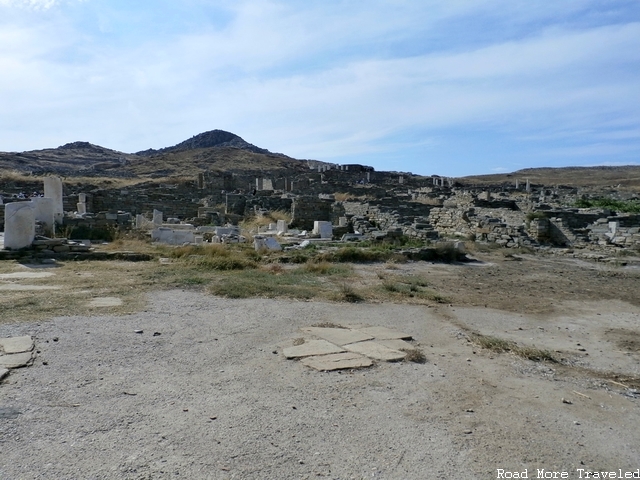
Following the birth of Apollo, the god of Light, Delos became known to the Greeks as the “Birthplace of Light”. Therefore, it grew in importance as devotees of Apollo flocked to the island. Delos flourished from roughly the 15th to 1st centuries B.C., and became one of the most important commercial centers of Greece thanks to the constant parade of religious festivals at the Temple of Apollo. It declined rapidly, however, after the Romans sacked the city in 88 B.C. Delos practically became a ghost town by the 3rd century A.D.
As you walk through the gates to the site, you enter the townsite’s “Main Street”, containing the town’s various temples. As you walk down the broad boulevard, various ruins of statue bases line both sides of the path. Unfortunately, many of the statues that were found here were plundered or stolen over the years; very few intact examples survive (the on-site museum displays a few, as described later). In the bottom photo, you can see all that remains for the most part – a “footprint” where a leg used to stand.
Also in this area are the ruins of the once fabulous Temple of Apollo. Today, not much remains aside from a few columns. Two large pieces of what was once an enormous statue of Apollo, remain, though: his mid section/belt loops, and a shoulder.
Moving past the Main Street area, you find the “Terrace of the Lions”. Numerous statues of lions meant flank the street, meant to guard both the temple of Apollo and the island’s oasis directly behind. Historians believe the terrace once contained between 9 and 19 lions, but only a few remain today. These are actually replicas; a few originals are on display in the museum. An interesting side note – the Venetians reportedly took a lion in 1716; it supposedly reminded them of the lion of St. Mark. They put a different head on the statute, and installed it in front of the Arsenale di Venezia, where you can still see it today.
As mentioned, on the right hand side of the path as you walk into the Terrace of the Lions is the island’s oasis. Fed by a small river, and aided by a layer of limestone underneath that effectively traps the water close to the surface, the presence of the oasis was vitally important to Delos given the dry climate, as it ensured a year-round water source.
A short walk uphill from the oasis is the museum, which houses a collection of original artifacts from the Delos townsite. While there are several artifacts and sculptures that are interesting to see, if you are short on time, there are two items in particular that you should see. The first is a set of four original lions from the Terrace of the Lions.
The second is a remarkable fresco, one that shows the god Dionysis with open wings riding a tiger. This is a really cool piece to see in person. It is also displayed on the cover of the leaflet you receive with your admission ticket.
Once we finished at the museum, we headed to the residential and commercial part of the old town. This part of the settlement was built on an uphill slope, which eventually leads to the town’s amphitheater. This is a view of the main path leading to the residential area – the highway out to the suburbs, if you will.
Below are two examples of the buildings you find in this quarter of town. The first is a “simple” house, albeit one with a nice view from the back, assuming there was a window there.
The second is a commercial district of sorts, with several shops clustered together back towards where the museum now stands.
As you head uphill, the houses become progressively fancier. Makes sense, since being up high meant a better view, and a shorter walk to the theater. This is probably the most spectacular of Delos’ residences, the House of the Trident. Besides the Corinthian columns, the living room also contains numerous mosaics. Just like today, wealthy residents commissioned works of art to display in their homes to show friends and business associates.
Nearby is the House of Dionysis, which contains a mosaic copy of the Dionysis-on-a-tiger fresco.
Finally, at the top of the hill is the town’s amphitheater. The Greeks, like the Romans, built amphiteaters for entertainment. The Greeks, though, put on dramas for their audiences, as opposed to the Gladiator matches famous in Roman settlements. The theater originally had a capacity of roughly 5,000, but only a few rows at the bottom remain today.
The Main Town of Mykonos
The theater marked the end of our tour of Delos; we then headed back to the ferry, and then the ship. After lunch at the pool grill, my wife and I met up with my brother to head over to Mykonos. Rather than take the bus tour offered by the ship, we elected to take the water taxi to town and just walk around ourselves. We had no real plan to speak of; just walk around for awhile, take some pictures, and grab a trinket or two before heading back to the ship.
Note: the town isn’t very large, and you can navigate most of it on foot in a few hours. But the terrain gets quite hilly as you head inland. It was a pleasant day on our visit, with a temperature in the low 80s, but it can get much hotter in July and August, and there is very little shade available in town. Carry plenty of water and know your own limitations before setting out.
The water taxis drop you off at the “Old Port”, which is right in the city center. We headed inland on one of the streets, and the charm of the Greek Isles became readily apparent. As you’ll see in Santorini and the other islands in the Cyclades, you wind your way down narrow, whitewashed streets with matching whitewashed buildings. Charming, indeed. Incidentally, we were in Mykonos two days before the debt default, but aside from a shop not wanting to make change for a 10 euro note, there was no noticeable effect in town.
Mykonos is surrounded to the west by hills, and so much like Delos, the town is built on a slope leading up the hill. About halfway up the hill (making for a convenient rest stop) is Cine Manto. Though it looks like an ancient Greek amphiteater, it’s actually a modern invention – an outdoor movie theater. It probably would be pretty cool to watch a movie here under the stars.
We eventually found our way to the main road leading out of town. It’s mostly hotels and restaurants up here, though if you head north, and then turn right at the sign for the airport and Ano Mera, there is a scenic overlook at the second switchback providing a nice view of the harbor. There are also several clear views of the town and harbor along the way.
View of Mykonos and harbor on the way to the overlook
And the view from the overlook
Once you’ve taken pictures at the overlook, if you head back to the main road and turn left (south), the road eventually takes you back downhill and to the southern entrance of the main town. Turn right near the Alpha Bank, and you’ll first reach the Mykonos bus station. A few blocks further down, you reach the famous Mykonos Windmills.
The Kato Myloi as they are called date to at least the early 16th century. Originally, the Greeks constructed them to produce power for grinding wheat; Mykonos harbor frequently receives strong winds due to the interaction of the sea with the hilly islands. The windmills fell out of use by the early 20th century, but have been preserved as a tourist attraction. Note, while this particular cluster of windmills is the largest in Mykonos, there are several others scattered throughout the island.
The area below the windmills also provides a great view of Mykonos’ most famous waterfrontneighborhood, Little Venice.
Though not built on canals like the real Venice, “Little Venice” gets its name from the colorful multi-level buildings on the harbor. Numerous bars and restaurants provide visitors the opportunity for a relaxing waterfront meal.
As we walked down the hill towards Little Venice, we stopped for a quick coffee at this place.
So I’ll give “Zorba” a zero for name creativity, but he does make a decent Greek coffee (or “Creek Coffee” per the menu) for 2 euros. That’s half the going rate in town, and they have free WiFi.
After a stroll through Little Venice, we made our way to the Paraportiani Church. Though the island of Mykonos has some 400(!) churches, Paraportiani is believed to be the oldest, and probably the most famous to visitors. Construction of the church began in 1475, next door to the medieval castle of Mykonos (since destryoed). However, the church ultimately morphed into a collection of five separate churches, which weren’t completed until the 17th century. The church has become an icon of sorts in Mykonos for its distinctive architecture, especially the rounded roof, and the view of the windmills from the rocks below.
The church is a short walk back to the pier, which brought our day in the Birthplace of Light to a close. But not before stealing one last view of this beautiful Greek town on the ride back.
Next stop: the small but delightful island nation of Malta.
Note: this post is part of my multi-part trip report series about our trip to Europe in June/July, 2015. Read the trip report introduction for an index and background about our trip.


